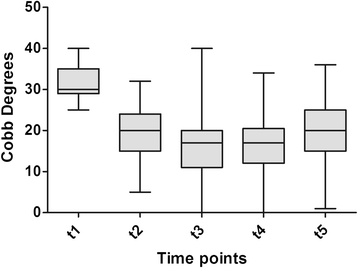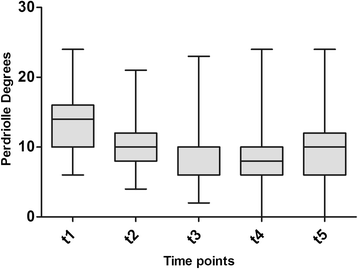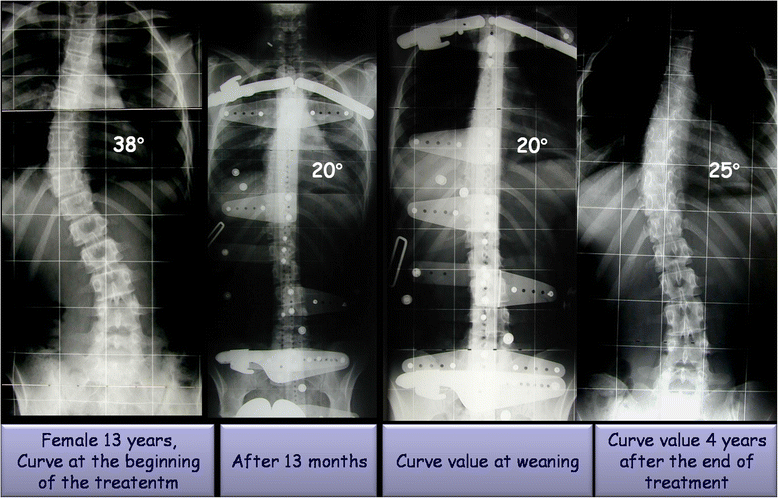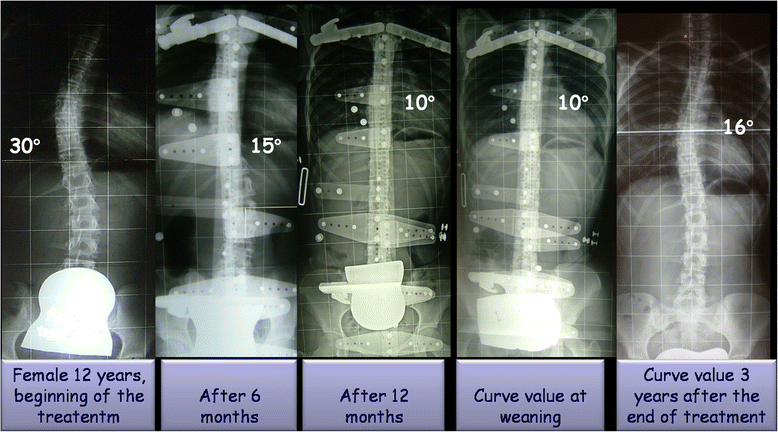Lyon bracing in adolescent females with thoracic idiopathic scoliosis: a prospective study based on SRS and SOSORT criteria
- PMID: 26497776
- PMCID: PMC4619531
- DOI: 10.1186/s12891-015-0782-0
Lyon bracing in adolescent females with thoracic idiopathic scoliosis: a prospective study based on SRS and SOSORT criteria
Abstract
Background: The Lyon brace is commonly prescribed in many European countries to patients with thoracic curves and is based on the three-point pressure system. The purpose of this study was to evaluate the efficacy of Lyon bracing for the conservative treatment of adolescent females with idiopathic thoracic curves in a case series selected on the basis of the Scoliosis Research Society (SRS) Committee on Bracing and Nonoperative Management Standardization Criteria and followed the guidelines on management of idiopathic scoliosis with corrective braces, proposed by the International Society on Scoliosis Orthopaedic and Rehabilitation Treatment (SOSORT).
Methods: Prospective study based on an ongoing database. From 1297 patients treated for idiopathic scoliosis between 1995 and 2014 fulfill the inclusion criteria 102 patients treated with Lyon brace. Of these, 69 patients had a definite outcome, 17 have abandoned treatment e 16 are still in treatment. The 104 patients were adolescent females with curvatures in the thoracic spine and a pre-treatment Risser score ranging from 0 to 2. All patients were prescribed with full-time Lyon bracing. The minimum duration of follow-up was 24 months after the end of weaning (mean: 41.64 ± 31.45 months). Anteroposterior radiographs were used to estimate the curve magnitude (CM) at 5 time points: beginning of treatment (t1), one year after the beginning of treatment (t2), intermediate time between t1 and t4 (t3), end of weaning (t4), 2-year minimum follow-up from t4 (t5). Three outcomes were distinguished: curve correction, curve stabilization and curve progression.
Results: The results from our study showed that of the 69 patients with a definite outcome the CM mean value was 31.51° ± 4.34 SD at t1 and 20° ± 7.6 SD at t5. Curve correction was accomplished in 85.5 % of patients, curve stabilization was obtained in 13 % of patients and curve progression was evident in only 1.5 %. None of the patients were recommended surgery post-bracing. Of 17 patients who abandoned the treatment, at the time of abandonment (14.4 age) have achieved curve correction in 13 cases (77 %), stabilization in 53 cases (18 %) and progression in 1 case (5 %).
Conclusion: The Lyon brace, through its biomechanical action on vertebral modeling, is highly effective in correcting thoracic curves in particularly when the SOSORT guidelines were adopted in addition to the SRS criteria.
Figures




Similar articles
-
Treatment of lumbar curves in scoliotic adolescent females with progressive action short brace: a case series based on the Scoliosis Research Society Committee Criteria.Spine (Phila Pa 1976). 2012 Jun 1;37(13):E786-91. doi: 10.1097/BRS.0b013e31824b547d. Spine (Phila Pa 1976). 2012. PMID: 22281476
-
Brace treatment in juvenile idiopathic scoliosis: a prospective study in accordance with the SRS criteria for bracing studies - SOSORT award 2013 winner.Scoliosis. 2014 Apr 23;9:3. doi: 10.1186/1748-7161-9-3. eCollection 2014. Scoliosis. 2014. PMID: 24817906 Free PMC article.
-
The outcome of a modified version of the Cheneau brace in adolescent idiopathic scoliosis (AIS) based on SRS and SOSORT criteria: a retrospective study.Eur J Phys Rehabil Med. 2016 Oct;52(5):618-629. Epub 2016 May 4. Eur J Phys Rehabil Med. 2016. PMID: 27145218
-
Standardization of criteria for adolescent idiopathic scoliosis brace studies: SRS Committee on Bracing and Nonoperative Management.Spine (Phila Pa 1976). 2005 Sep 15;30(18):2068-75; discussion 2076-7. doi: 10.1097/01.brs.0000178819.90239.d0. Spine (Phila Pa 1976). 2005. PMID: 16166897 Review.
-
Discontinuation of brace treatment in adolescent idiopathic scoliosis (AIS): a scoping review.Spine Deform. 2024 Sep;12(5):1217-1228. doi: 10.1007/s43390-024-00882-3. Epub 2024 May 1. Spine Deform. 2024. PMID: 38693334 Free PMC article.
Cited by
-
Brace and Physiotherapeutic Scoliosis Specific Exercises (PSSE) for Adolescent Idiopathic Scoliosis (AIS) treatment: a prospective study following Scoliosis Research Society (SRS) criteria.Arch Physiother. 2022 Nov 1;12(1):22. doi: 10.1186/s40945-022-00150-5. Arch Physiother. 2022. PMID: 36316760 Free PMC article.
-
A comparison between Boston brace and European braces in the treatment of adolescent idiopathic scoliosis (AIS) patients: a systematic review based on the standardised Scoliosis Research Society (SRS) inclusion criteria for brace treatment.Eur Spine J. 2024 Feb;33(2):630-645. doi: 10.1007/s00586-023-08007-6. Epub 2023 Nov 4. Eur Spine J. 2024. PMID: 37924388
-
The natural history of curve behavior after brace removal in adolescent idiopathic scoliosis: a literature review.Spine Deform. 2023 May;11(3):567-578. doi: 10.1007/s43390-022-00638-x. Epub 2023 Jan 30. Spine Deform. 2023. PMID: 36715866 Free PMC article. Review.
-
The Effects of Short- and Long-Term Spinal Brace Use with and without Exercise on Spine, Balance, and Gait in Adolescents with Idiopathic Scoliosis.Medicina (Kaunas). 2022 Jul 29;58(8):1024. doi: 10.3390/medicina58081024. Medicina (Kaunas). 2022. PMID: 36013490 Free PMC article. Clinical Trial.
-
Bracing In The Treatment Of Adolescent Idiopathic Scoliosis: Evidence To Date.Adolesc Health Med Ther. 2019 Oct 8;10:153-172. doi: 10.2147/AHMT.S190565. eCollection 2019. Adolesc Health Med Ther. 2019. PMID: 31632169 Free PMC article.
References
-
- Wang W, Zhu Z, Zhu F, Sun C, Wang Z, Sun X, et al. Different Curve Pattern and Other Radiographic Characteristics in Male and Female Patients with Adolescent Idiopathic Scoliosis. Spine (Phila Pa 1976) 2012. [Epub ahead of print]. - PubMed
-
- Grivas TB, Kaspiris A. European braces widely used for conservative scoliosis treatment. Stud Health Technol Inform. 2010;158:157–166. - PubMed
-
- de Mauroy JC, Fender P, Tato B, Lusenti P, Ferracane G. Lyon brace. Stud Health Technol Inform. 2008;135:327–340. - PubMed
Publication types
MeSH terms
LinkOut - more resources
Full Text Sources
Other Literature Sources
Medical

